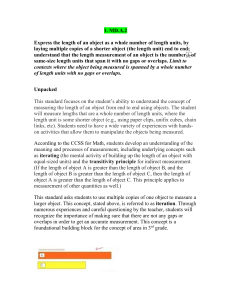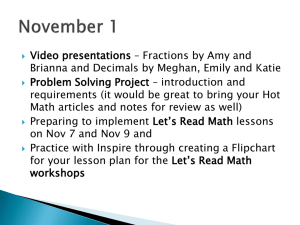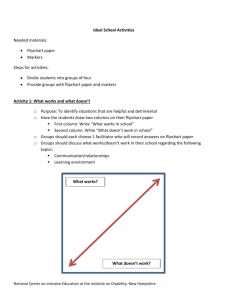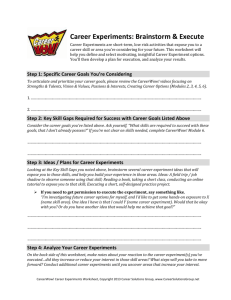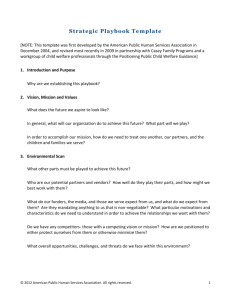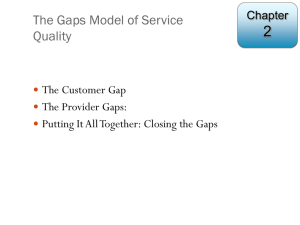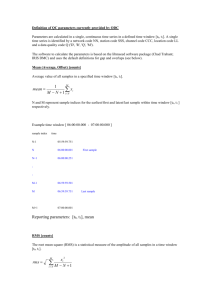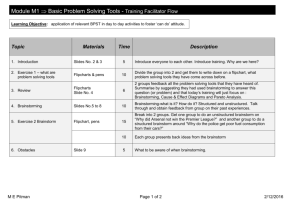Workshop Outline in MS Word
advertisement
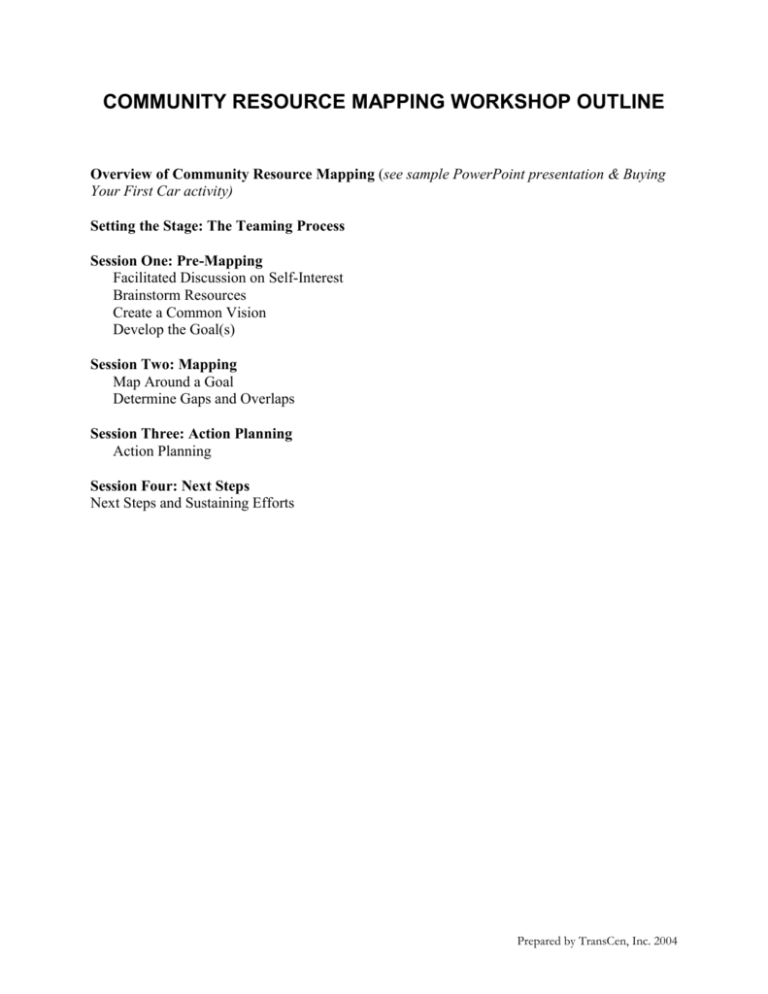
COMMUNITY RESOURCE MAPPING WORKSHOP OUTLINE Overview of Community Resource Mapping (see sample PowerPoint presentation & Buying Your First Car activity) Setting the Stage: The Teaming Process Session One: Pre-Mapping Facilitated Discussion on Self-Interest Brainstorm Resources Create a Common Vision Develop the Goal(s) Session Two: Mapping Map Around a Goal Determine Gaps and Overlaps Session Three: Action Planning Action Planning Session Four: Next Steps Next Steps and Sustaining Efforts Prepared by TransCen, Inc. 2004 OVERVIEW OF COMMUNITY RESOURCE MAPPING Purpose: Provide a general overview of resource mapping. Instructions: 1. Provide a general overview of resource mapping. (Consider using the sample resource mapping PowerPoint slides.) 2. [Optional] Resource Mapping Activity: Buying Your First Car. See instructions with the activity. SETTING THE STAGE: THE TEAMING PROCESS Purpose: Prior to getting started, provide an overview of the teaming process. Instructions: 1. Introduce yourself, the recorder (if you have one), and ask team members to do the same. Quickly review roles, purposes, goals and the workshop agenda. Suggested Flipcharts: Introductions Roles at the Workshop Purpose & Goal of Workshop 2. Quickly review the groundrules, consensus-building parameters, and “parking lot” concept. Suggested Flipcharts: Groundrules Consensus Parking Lot SESSION ONE: PRE-MAPPING Purpose: To work through the pre-mapping components of the mapping process: identifying self-interest, identifying existing resources, developing a common vision and establishing goals. Activity One: Facilitated Discussion on Self- Interest Purpose: To identify the team’s (or individual team member’s) self-interest in being a partner in developing of a comprehensive system. Instructions: Ask each team member to respond to each of the following questions. Record their responses on a flipchart. Why is it in your (or your organization’s) self-interest to participate in a mapping process to develop of a comprehensive system? What do you (or your organization) need to be getting on an ongoing basis to stay engaged in this work? Identify your priority need. Prepared by TransCen, Inc. 2004 Activity Two: Brainstorm Resources Purpose: To produce a comprehensive list of the various resources (organizations, funded projects, programs, initiatives, & funding sources) in your community. Instructions: Using Mapping Tool One*, brainstorm a list of all organizations, funded projects, programs, and initiatives in your community that play a role in the success of youth in your community. Record the list of resources on a flipchart/or on Mapping Tool One. Keep this list posted. *Mapping Tool One can be adapted to capture those domain areas unique to the system you want to map and align. Encourage discussion among team members by asking the following questions: How are all these resources connected in your community? Do you view these resources as a bunch of programs or as a potential system? What would be the benefit of organizing these resources into a coherent system? Activity Three: Create a Common Vision Purpose: To come to consensus on a common vision for mapping (e.g., creating an ideal system for serving youth in your community). Instructions: If you have a large team, break them into smaller groups. Provide each group with markers and a piece of flipchart paper. Ask participants to create/draw their vision. Think about key elements that form an ideal system. Then, have the group(s) translate their creation/drawing into key words or key themes. Have each small group explain their vision (drawing) to the rest of the team. From the small group work, work as a team to write a common vision. If time is limited do not get hung up on word-smithing. Activity Four: Develop the Goal(s) Purpose: To identify 2 or 3 measurable goals that will allow the team to achieve its common vision. Instructions: Ask the team to think about what is needed to help meet their vision (e.g., build a comprehensive youth system; improve secondary education and transition systems). Brainstorm 2 or 3 measurable goals (targeted outcomes) that are priorities for your team. Record the goals on a flipchart. Keep the list posted. Encourage discussion among team members by asking the following questions: What are the desired outcomes, in measurable terms? What will be different after your plan is completed? Prepared by TransCen, Inc. 2004 SESSION TWO: MAPPING Purpose: To map the resources associated with one identified goal, and to identify the gaps and overlap in resources in your community. Activity Five: Map Around a Goal Purpose: To map the resources around one identified goals, starting with the resources “at the table.” Instructions: Have the team select one goal to map. Using Mapping Tool Two, identify resources in your community to reach that goal. Using post-it notes, have each team member provide information on the resource(s) they bring to the table. Have each member complete the necessary information for each box [see Mapping Tool Two] on separate post-it notes, and post them on the wall chart of Mapping Tool Two in the appropriate boxes. Then, have each team member describe their program. As members explain their resources, pay particular attention to any gaps or overlaps in services. Note these on a flipchart. Encourage discussion among team members by asking the following questions: What overall strategies will your team use to obtain this goal? What community resources are available beyond the traditional resources? Activity Six: Determine Gaps and Overlaps Purpose: To identify the gaps and overlaps in resources in your community, and how they impact your service delivery system and outcomes. Instructions: Using Mapping Tool Three, list the gaps and overlaps in resources in your community. Then, determine the implications of these gaps and overlaps for your community. Begin to think about the action steps that need to happen to address these gaps and overlaps. Remember, gaps and overlaps may occur in services and supports, partners, youth populations served, funding sources, data collection efforts, etc. Encourage discussion among team members by asking the following questions: Are there gaps in services? Are resources duplicated or overlapping? What are the implications for these gaps and overlaps? SESSION THREE: ACTION PLANNING Purpose: To begin developing an action plan around one goal, including potential technical assistance (TA) needs and “next steps.” Activity Seven: Action Planning Purpose: To identify action steps/strategies to align existing resources, identify new resources, and reduce duplication of resources. Prepared by TransCen, Inc. 2004 Instructions: Review the identified goal, the community resources that support this goal and the gaps in services. Ask the team to brainstorm action steps/strategies for better aligning or using these resources. Remember to think about actions to eliminate the identified gaps and overlaps. Record the responses on a flipchart and/or on Mapping Tool Four. Keep this list posted. Encourage discussion among team members by asking the following questions: How well are programs and services linked together? What are the barriers to aligning programs and services? What action is required? What impact will this action have on your community? How will your team support the action plan through money and in-kind contributions? What observable tasks will your team take to achieve your overall action plan? Who will be responsible for each step? By what date will each task be completed? How will your team evaluate your action steps to determine their success? SESSION FOUR: NEXT STEPS Purpose: To identify the technical assistance needs associated with the action steps, and to determine what needs to happen next in the planning process. Activity Eight: Next Steps and Sustaining Efforts Instructions: Using Mapping Tool Five, ask the team to brainstorm the types of technical assistance (TA) they may need to implement their action plan. Think about TA needs at the local, state and national levels. Identify the TA connections already in place in the community. Record these on a flipchart and/or Mapping Tool Five. Post this list. Continue using Mapping Tool Five to record what needs to happen to sustain this action planning after this workshop. Encourage discussion among team members by asking the following questions: How will your team implement this action plan to further improve your practices? What technical assistance will your team require to implement these actions? What technical assistance is already available to the community partners? How will your team celebrate and communicate the plan’s success? How will your team sustain these successes? How will your team solicit support for future endeavors and collaborative efforts? Prepared by TransCen, Inc. 2004 Prepared by TransCen, Inc. 2004

